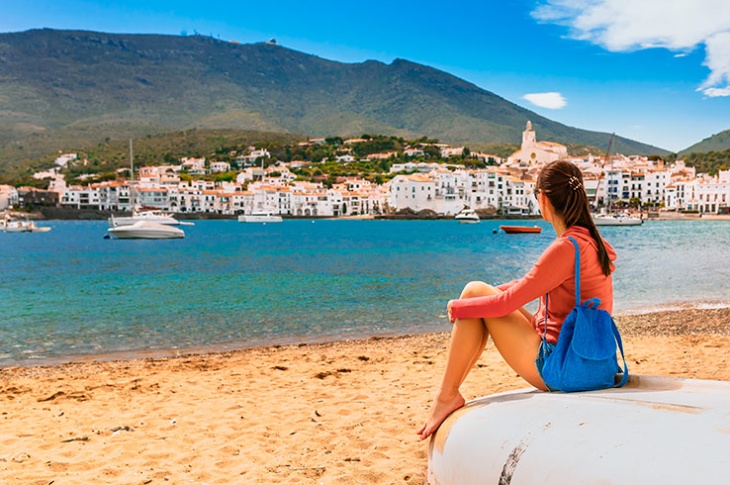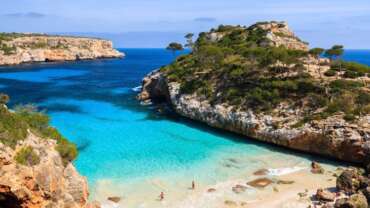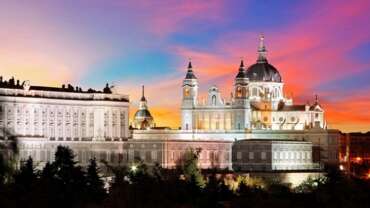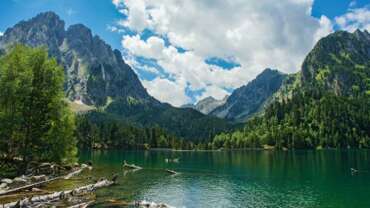Madrid - THE CAPITAL CITY WITH A THOUSAND OPTIONS
Madrid, cheerful and vibrant at all hours, is famous for being an open city with all kinds of people from anywhere in the world.
In addition to its famous museums, busy streets dotted with all kinds of shops, restaurants with world cuisine or unbeatable nightlife, Madrid will surprise you with its charming, tranquil historic spots, with traditional and family-run century-old bars where friends meet up for a drink, all kinds of neighbourhoods, and cultural centres that offer an alternative type of tourism. Madrid has an authenticity that is hard to match. It is welcoming and diverse. Madrid is, without a doubt, one of Europe’s most interesting cities.
Culture and leisure at any time
Anyone in search of culture will find some of the most important museums in the world, such as the Prado, Reina Sofía or Thyssen. But we must not forget smaller options, full of charm, such as the Sorolla Museum or cultural centres like the Matadero or Conde Duque, which are continuously offering innovative exhibitions, concerts, guided tours, etc.
Walking around Madrid means coming across iconic spots such as the stunning Royal Palace, the Plaza Mayor with 400 years of history, the buzzing Puerta del Sol, the famous Gran Vía full of shops, or the four tallest towers in Spain. Each neighbourhood offers a different experience: La Latina is ideal for tapas, Las Letras has the perfect combination of literature and fine dining… But Madrid also means relaxing in enormous parks such as the Parque del Retiro, and other lesser-known but equally charming parks like El Capricho.
Capital of food, fashion and nightlife
When it comes time to eat Madrid has two facets, both equally delicious. On the one hand, traditional bars where you can discover the old-fashioned, unpretentious atmosphere known as ‘castizo’, and why tapas are so much fun. On the other hand, avant-garde restaurants such as DiverXO and traditional markets converted into new gourmet spaces like San Miguel, which have become true temples of gastronomy. In Madrid, any time is a good time to enjoy a lively, urban atmosphere. For example, the increasingly famous weekend brunches in enclosed glass terraces, courtyards, rooftops, etc.
Fashionistas will find all options: luxury stores on the Golden Mile, vintage establishments in areas such as Fuencarral, new designer markets like the Mercado de Motores, and craft shops and bookshops over 100 years old. At dusk, some of the city’s viewpoints will surprise you with unique sunsets, at the Temple of Debod or the rooftop bar of the Círculo de Bellas Artes, for example. And at the end of the day… nightlife in Madrid is legendary with live music, all kinds of ambiences, music until the sun comes up…
Valencia – THE MEDITERRANEAN AS A CITY
A place full of contrasts awaits the visitor with a charming old town next to futuristic buildings. This is Valencia, one of Spain’s most welcoming cities to spend a few days. Beyond the cultural effervescence of its cities, a stroll is always a good idea, or bathing at its Mediterranean beaches. Of course, you must try the star dish, paella (true authenticity!) and other delicacies such as clams or tiger nut milk.
Any time is a good time to visit Valencia, although if there is one day that is even more special than the rest, it’s 19 March, when they celebrate the famous Fallas by burning gigantic ‘cardboard sculptures’. Its Mediterranean light, mild climate and the bewitching fire make this a city you’ll want to stay in.
A cultural visit: between classic and avant-garde
Valencia is perfect to discover on foot One of the most fascinating attractions is the Plaza de la Reina, with the Cathedral and the Miguelete tower, where you should climb the 207 steps for some beautiful views. In the city centre you can also find the Silk Exchange -one of Valencia’s most beautiful buildings, a World Heritage Site, with its idyllic Patio de los Naranjos courtyard full of orange trees- and the Modernist Central Market – Europe’s largest fresh produce market, so taking in its stalls is a true experience. A few metres away is the National Ceramic Museum with its impressive façade or the Quart and Serrano Towers. And also museums such as the IVAM or many surprising spots full of street art.
A little further from the centre you can see the more modern side of Valencia: the City of Arts and Sciences. Designed by Santiago Calatrava and Félix Candela, it has fought to become a landmark with buildings such as the Oceanogràfic, Europe’s largest aquarium. Its original shapes make the ideal backdrop for taking a photo.
A paella by the sea
There is no better plan than visiting one of the large beaches and having a paella by the sea. Valencia offers over 300 days of sun a year. The Malvarrosa beach is one of the most well-known options. Once there, the fine golden sand and blue water remind you of the famous paintings in which Sorolla would depict the city. How could you resist a dip in the sea?
Those looking for ‘wilder’ landscapes can visit El Saler, or El Palmar and try its famous paella. You can end the day taking in the sunset at the Albufera, a navigable lake next to the sea known as the ‘mirror of the sun’, where you can see the best sunsets on the Mediterranean.
The beach is not the city’s only outdoor plan, you can also take a walk along the huge Turia city garden or a family visit to the Bioparc zoo.
When the evening comes, there is nothing better than sitting at a terrace or innovative or Michelin Star restaurant and taking in the buzzing nightlife atmosphere of El Carmen, or new fashionable areas for foodies such as Ruzafa.
Barcelona – A Cosmopolitan City
Barcelona is a city with a wide range of original leisure options that encourage you to visit time and time again. Overlooking the Mediterranean Sea, and famous for Gaudí and his Art Nouveau architecture, Barcelona is one of Europe’s trendiest cities.
It’s a hub of new trends in the world of culture, fashion and cuisine. It combines the creativity of its artists and designers with respect and care for local traditions. The charm and slower pace of the old town, the avant-garde vibe of more modern neighbourhoods, and the fast pace of one of the world’s most visited cities coexist in Barcelona.
Trendy destination
Barcelona is a showcase for the latest developments in fashion. Strolling around its streets you can discover a world of options for a day of shopping. From glamour and major brands in iconic stores set in emblematic buildings, such as the Paseo de Gracia or Avinguda Diagonal, to alternative and innovative design in areas such as the Born district. Barcelona is also brimming with traditional shops and you can visit century-old stores and ateliers that will surprise you with their attention to detail.
The Mediterranean character and streets full of ambience also set the trend in Barcelona. The possibilities are almost endless, ranging from popular options such as a stroll down Las Ramblas or traditional markets such as La Boquería, to relaxing moments on the city beaches or the many pavement cafés in the old town. You can even discover the city in an original way with Barcelona Tourist Office’s programme of tours. These include guided and themed tours; routes in vintage cars, or on segways or bicycles; boat tours, and helicopter flights.
A city to visit again
Barcelona draws visitors to its famous sights, like the Sagrada Familia, Parc Güell, Casa Batlló and La Pedrera. But they can also discover a city full of pleasant surprises on each trip.
A walk along the seafront, evenings on a rooftop terrace with views over the city skyline, spacious parks such as Parc de Montjüic or Ciutadella, the marina, Olympic village or anything to do with FC Barcelona; a range of options for new experiences on each visit.
Culinary options are also varied, with world renowned haute cuisine restaurants, traditional Catalan dishes, food markets, and establishments that take you around the world with their flavours…
The city’s cultural agenda also includes major art centres, like the Picasso Museum, the National Art Museum of Catalonia, and CaixaForum; a wide range of festivals and one of Spain’s leading opera houses, Gran Teatre del Liceu.
Seville – An inspiring Destination
Seville is a city that leaves its mark, and many people define it as special. It might be because of the grandeur of its monuments. Or perhaps the charm of areas such as Triana.
It may possibly be the scent of jasmine in its squares or the Spanish guitar music of its streets. Some say that it’s the tradition of its festivals, and many are convinced its tapas are the real reason.
A monumental city
You can see it for yourself in the few metres that separate the Giralda tower, the Cathedral and the Real Alcázar of Seville. La Giralda is a city icon and one of its main charms lies in its viewpoint. The views of Seville are fantastic with its courtyards of orange trees, typical in Andalusia, and a close-up of the largest Gothic temple in Europe, the Cathedral. A visit to the Real Alcázar reveals an extraordinary palace full of details. If you visit in the summer, take advantage of the night visits and the festival held in its gardens.
Seville is much more than its undeniable monumentality. It is a city of lively streets and large open spaces such as the huge Plaza de España, María Luisa Park or the avant-garde Metropol Parasol. And if you want to enjoy the authentic atmosphere of Seville, try going for tapas in the old town, in popular areas such as Alameda, Macarena, Nervión, Los Remedios or Triana. Marinated ‘pescaíto’ (fish), small filled rolls, typical snails, fino (white wine), manzanilla (sweet wine) or a cold beer are a must on any tapas outing.
Popular tradition of the south
In Seville, tradition is always in fashion. From flamenco shows and Spanish guitar music to typical ceramics and crafts, which are always a good souvenir of the city. There are plenty of shops and workshops in Triana. And it’s easy to enjoy flamenco at one of the many ‘tablaos’ or neighbourhood ‘peña’ groups. In fact, Seville hosts what is perhaps the most important international festival of this art: The Biennial.
The tradition of Seville is also reflected in its more international festivals. Two good examples are the April Fair and Holy Week. The first is all about joy and passion for popular Andalusian art, an unbeatable chance to enjoy the sound of the Spanish guitar, flamenco fashion and festive Seville. Holy Week is a passionate festival full of emotional moments. To understand it, the best option is to witness one of the much-visited religious processions or hear a live ‘saeta’ (emotional flamenco song dedicated to the religious figures).
Malaga – THE CAPITAL OF THE COSTA DEL SOL IS REINVENTING ITSELF
Beyond its 16 sunny beaches, this Andalusian city on the shores of the Mediterranean has a fascinating cultural side. And the birthplace of Pablo Picasso has reinvented itself in recent year, inaugurating museums for all tastes.
If you take the combination of sea and culture and add a lively atmosphere, plenty of tapas served in its bars, fashionable neighbourhoods like Soho, areas such as the port that have been transformed to offer a more modern image, and monuments with centuries of history, the result is an exciting city everyone would want to discover. Because if everyone says that Malaga is prettier than ever then it must be true.
A journey in time
Malaga is a city full of historical spots such as the Alcazaba, one of the largest Moorish fortresses in Andalusia, or Gibralfaro Castle, which offers the best views over the city. At the foot of the castle there is a Roman theatre and an old town to stroll around. Its streets offer attractions such as the Atarazanas Market to have a vermouth, and monuments like the Cathedral, known as ‘La Manquita’ (one-armed), due to its unfinished right tower. You can’t miss visiting its roof; a unique experience. Here in the city of Picasso, you can visit the excellent Picasso Museum in the centre, and the home where he was born.
But Malaga doesn’t only live on its past. In recent years it has inaugurated the Carmen Thyssen Museum, the only Pompidou Centre outside France -its coloured cubes have become an icon- or the Saint Petersburg Russian Museum Collection.
But anyone looking for a more underground culture simply must visit the Centre for Contemporary Art, the urban art on the city’s buildings or the alternative establishments in Soho.
Essence of Malaga
Several things make Malaga a unique place. To start, beyond its monuments, a sunny day spent on the legendary La Malagueta urban beach is a must. Anyone who wants to delve into traditional flavours should visit the seaside neighbourhood of Pedregalejo and try the typical grilled sardines on skewers.
Back to La Malagueta, nearby you can find Muelle 1, a port promenade full of shops and restaurants that is perfect for a sunset stroll to La Farola, a lighthouse that is a symbol of the city.
Another emblem of Malaga? Without a doubt its pedestrian street Marqués de Larios, a busy thoroughfare decorated with flowers and which you must visit at least once on a trip to Malaga. At night, this area and its nearby streets become the perfect spot for tapas at establishments that have become an institution, such as Bodega El Pimpi; and for trying the ajoblanco chilled garlic soup.
Malaga is also known for its Film Festival, its Holy Week, its innovative restaurants… But above all, Malaga is joy. And it’s catching.
Zaragoza – A GREAT CITY WITH LOTS TO DISCOVER
It is one of Europe’s great cities, recognisable for its stunning Basilica of El Pilar and for its festivities held every October.
Highlights of a visit to the city include a Moorish palace, a Roman forum, avant-garde bridges, a museum dedicated to the great Spanish artist Francisco de Goya, and of course, tapas in the district of El Tubo.
Spaces full of life
Large squares, spacious pedestrian areas in the centre, an area known for its bars, a huge city park, kilometres of bike lanes… Zaragoza is one of those destinations where it is easy to feel at home.
The city revolves around the large Plaza del Pilar, the setting for the city’s main celebrations. El Tubo, the quintessential district for tapas, is just 15 minutes from the iconic square. And throughout this area there are many pedestrian streets full of places to shop. They include Alfonso I, the nearby Calle Don Jaime and Avenida del Coso.
Zaragoza stands next to one of Spain’s most important rivers, the Ebro. You can ride a bicycle along part of its banks, from the old town to the Agua Luis Buñuel Metropolitan Park. On the way you can take in the different designs of its bridges, from the historical Puente de Piedra stone bridge, to the avant-garde Pabellón Puente pavilion bridge, created to mark the 2008 International Exhibition. In the park you can visit one of Europe’s largest river aquariums.
And a monumental city
The Basilica of Nuestra Señora del Pilar is Zaragoza’s leading monument. One of the city’s symbols and one of its two cathedrals along with the nearby Seo. In addition to visiting both churches, it’s worth climbing to the basilica’s viewpoint to take in the city. La Seo and the church of San Pablo are part the Aragon Mudejar art declared a World Heritage Site.
Another essential visit is the Aljafería Palace. Despite seeming like a military palace with no relation to the Moorish world, inside it houses a mosque, a courtyard of orange trees, and wonderful examples of Moorish architecture.
Zaragoza offers two very interesting cultural routes. The first follows in the footsteps of artist Francisco de Goya in the city. The second reveals the Roman past of Zaragoza with visits to the Forum Museum or the Caesaraugusta Theatre Museum, among others.
Canary Islands
These islands are known for being the sunshine centre of Europe, and offer mild temperatures and a range of outstanding natural attractions. In fact, five of its seven islands have been declared a Biosphere Reserve, and the archipelago has four national parks.
Its beaches are its most outstanding attractions, and are perfect for relaxing in the sun or enjoying water sports such as windsurfing and scuba diving. In the interior you’ll find amazing landscapes which are ideal for hiking, cycle touring, rock climbing and even caving.
Some of the most spectacular include the volcanic scenery of Lanzarote, the beaches of Fuerteventura and Gran Canaria with their sand dunes, or the green forests of La Palma and La Gomera.
The Canary Islands also offer a range of cultural options to explore, including the monumental site at San Cristóbal de La Laguna, which has been awarded the World Heritage designation by the UNESCO, and the work of César Manrique in Lanzarote. If you’re going in February you’ll also be able to enjoy the spectacular Carnival in Santa Cruz de Tenerife.








